Dr Vino's wine blog
wine talk that goes down easy
The best white wine under $15
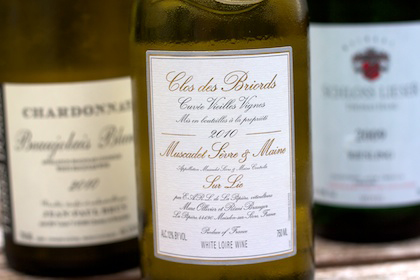
What’s the best white wine currently in the US market for about $15? I’ll make a case for the 2010 Clos des Briords from Marc Ollivier (Domaine de la Pépière).
The 2010 is electric. After the 2009 had more ripeness, I find 2010 a reversion to the exciting norm of citrusy freshness and minerally, iodiney verve. Pairing it with seafood, particularly shellfish, is probably about as much fun as you can have with a $15 white wine. (search for this wine at retail) The wine comes from a single vineyard in Muscadet, one of vines planted in the 1930s. The wine stays on its lees up until bottling, which also helps account for more depth than your average Muscadet. It’s also particularly age-worthy, and I’m scouting out some magnums to tuck away. Emphasizing the minerailty over fruitiness means this wine isn’t for everyone. But for those who love wines so taut you could play a DVD on them, check out what is the best white value out there.
A runner-up would certainly be the Terres Dorées Beaujolais Blanc, a Chardonnay, also from 2010 (above, left). The wine is a perennial better value, but the 2010 exhibits a value chardonnay in its minerally, unadorned form that is stunning. (On a related note, I was a huge fan of the 2009 red Terres Dorees, but didn’t find the 2010 red to have the same snap.)
Which wine would you nominate as the best white wine around $15 in the market today?
The best bottles are the quickest emptied: Mugnier edition
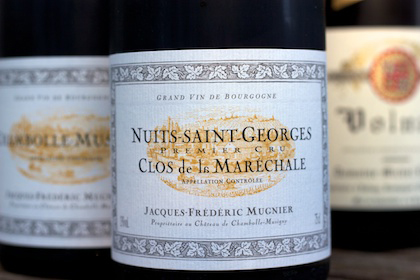
The best bottles are the quickest emptied. But you knew that.
Last week, I made my wife a birthday dinner. But before I started covering the kitchen counter and, inadvertently, the floor and my clothes with flour to make fresh pasta, I popped open a bottle of slightly chilled Mugnier Clos de la Marechale 2007. By the time we got to the table, I was dismayed to find most of the wine had evaporated!
The 2007 Clos de la Marechale is drinking very well now. I had the good fortune of tasting the 08 and the 09 this week too at a trade tasting. While the 07 is the least heralded of these vintages, it is certainly not one to overlook with delicious balance of fruit, acidity and tannin. The ’08 has more red berry notes, acidity, tannin, balance and gorgeous oomph that bodes well for a long cellar life. The ’09 has more dark fruit character, slightly more ripeness and roundness and elegant concentration, with a spice note that culminates an a faint whiff of pepper. All bear the signature of Frédérique Mugnier for the “bargain” price of under $100. (Find these wines)
Peter Wasserman, who works to export the wines, told me that “Freddy” Mugnier, the winemaker and a former petrochemical engineer, has undertaken a geological survey of the vineyard this year. While the wine making remains very hands-off, for the first time, he will be harvesting the grapes from similar soils and making the wines by those parcels instead of by vine age (45 – 70 years old). All the vats will still be blended in to the 2011 Clos de la Marechale.
France underground: a wine map meets Metro map
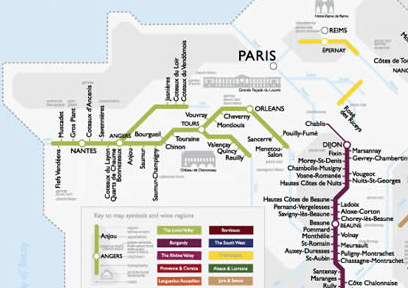
Have you ever thought about the iconic Tube maps from London or the Paris Metro maps, in all their stylized glory, and how they would look applied to wine regions?
Well, wonder no more. San Francisco architect and professor David Gissen worked up just such a map; now it is available for purchase as a cool 18 x 24 wall decoration. Each region gets its own color like one of the subway lines and the subregions are various stops. Here’s what Gissen said via email about his inspiration for the map:
I guess I made the map as a sort of loving critique. I feel that the American appreciation of EU wine is dominated by a pastoralist point of view and aesthetic. If I see another picture of a vineyard or pruning shears, or a wine map that looks like a hiking map, I might lose it. I believe that French wine (like all EU wine) was born in and through villages, towns and cities. From my perspective it’s completely urban. I want to make some artifacts that express my point of view. The map is the first of these. I may make others, but I’m not sure. Of course, if you need to learn the appellations, the metro-wine map is useful, but I’m not primarily interested in its instrumentality. I’m more interested in its ability to shift what we understand wine to be.
Vintage 2011: wacky wine weather
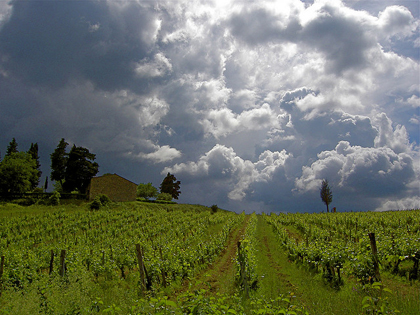
Weather: it’s what you discuss in elevators or with the in-laws. But if you’re a winemaker or even a wine consumer, it can actually be pretty important.
And things are heating up in talking about weather in the wine world. Especially if you are in Bordeaux that is, since it is en fuego! Or something like that: The heat has been abnormally high and the rainfall is way below average. So if the drought-like conditions keep up, the reduced supply of grapes could push wine prices even higher! Is it 2003 all over again? The vintage in Burgundy is also advanced.
By contrast, cut to the Auction Napa Valley this past weekend and people were breaking out the umbrellas rather than the sunscreen. Weather has been cool across the state. Rhys Vineyards has vineyards in more of the marginal weather areas of California and therefore is rightfully weather-obsessed, so their Twitter feed is an excellent source of weather info. Temperatures at their Skyline Vineyard, perched at 2,300-ft elevation, hovered at 49.6 degrees Fahrenheit in May, making it one of the seven coldest Mays since 1931; their vine shoots are about two or three inches behind, they tweet. They say that weather in late June is key for the fruit set so they don’t mean to sound gloomy. And after California’s cool and damp 2010 vintage, the “high-octane,” “fruit-bomb” style is taking it from all sides these days.
Australia was in the headlines for the devastating Queensland floods earlier this year. But even some of the wine growing regions were hit by heavy, “seven year rains” that rotted unpicked grapes quickly and made for a lot of grape selection both in the vineyard and on sorting tables. The Sydney Morning Herald explicitly linked the “soggy” weather to lower alcohol levels.
It’s weird that California and France appear to have flipped weather so far for 2011–there’s something you can talk about in your next elevator ride. Just don’t let the Mayans know since I think that was part of their their 2012 prophecy…
Aging Muscadet on the lees – and a Melon de Meursault
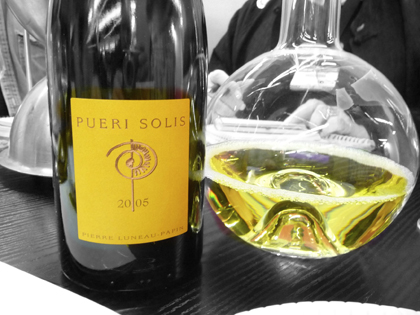
Muscadet gives pleasure when it is freshly squeezed. But aging the best examples can be worth the wait.
Muscadet gains richness with time spent on the lees. Lees are neither Confederate generals nor blue jeans but rather spent yeast cells that fall to the bottom of the barrel or tank when their work is done. Stirring them can give a wine a broader, heftier feeling–without at all adding woodiness.
At Luneau-Papin, the wines not only highlight different soil types, but also different lees aging.The tasty “L d’Or” comes from both granite and gneiss soils and sees 11 months on the lees. (This wine can also do well with extended aging in bottle as the 1999 I recently tasted was fresh and delicious.) The golden “Excelsior” bottling, from schist soils, sees 36 months on the lees and is creamier and richer. Their structured “Peuri Solis” sees 42 months on the lees before bottling.
As the name of the grape (Melon de Bourgonge) suggests, it originally hailed from Burgundy. Some juice from Pierre Luneau-Papin’s vineyards recently made a trip back to Burgundy to be made into wine by none other than the maestro J-F Coche, making me wonder if it would be, in fact, be a Melon de Meursault. A call to Coche (he has no email or website I could find) divulged that he had, in fact, mad a “miniscule” amount of Melon de Bourgogne. Coche-Dury has been known to drive wine enthusiasts to the brink of their senses in seeking out his wines. Alas, this curiosity won’t ever be available commercially as Coche says it for “personal consumption.” But it sure would be fun to try! Read more…
Did social media save a winery from bankruptcy?
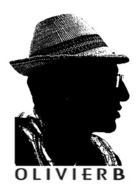 Facebook and Twitter may contribute to toppling regimes these days. But can social media save a winery from falling into the abyss?
Facebook and Twitter may contribute to toppling regimes these days. But can social media save a winery from falling into the abyss?
A case study is unfolding in France. On January 1, a small wine producer going by the name of “Olivier B.” announced on his web site that he was hanging it up. He makes a range of reds and whites from the Côtes du Ventoux appellation that sell for about 12 – 30 euros. He put a picture of his bottles in the shape of a cross, with the hat that adorns the labels of all his wines in the middle, and said it had been his cross to bear for the past few years and the dream was over. His love was lost, both the winery and his parter (simply, “elle”) who said she could not support him any more in this venture. The warehouse where he made his wine was for sale and the bank wouldn’t grant him a line of credit to buy it.
The French blogosphere then turned Olivier B. into a cause celebre for the misfortune of small vignerons. Many rallied to his cause (see a summary). Two bloggers organized a public tasting of his wines in Paris. The big breakthrough appears to have been when the Miss Glou Glou blog at lemonde chimed in. Then a local paper, La Provence, picked up his story. Then AFP ran a story. The media tsunami continued with TV channel Canal+ and radio stations from France, Belgium and Switzerland running stories. Traffic to his blog took off. But more importantly, sales started flowing, and he had 20,000 euros of sales in two weeks.
He wrote in a posting on his blog that making “Parkerized” wines was never his objective but during his deepest, darkest moments, he did think that if he got a 95-point score from Parker that all his problems would be solved. But now, he says, thanks to the blogosphere he has “hundreds of Parkers” to thank for the turnaround.
This fascinating story isn’t over, of course. Check out Olivier’s blog for the latest. One interesting aspect is that despite the apparent globalization of the internet, this story hasn’t reached the English language blogosphere or media. Another is that the blogosphere rallied in an advocacy mode. Whether and how many times it could be repeated is an open question. But certainly Olivier B. is glad it has worked so well this time.
Assessing risk and reward in white Burgundy
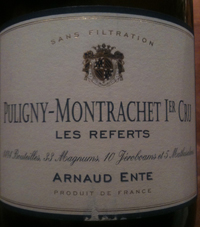 It’s not every evening I get to taste ten white Burgundies with a decade or so of age. For one, they’re often expensive. But they’re also a category that has not been aging well in the bottle, thanks primarily to the issue of “premox,†or premature oxidation, the cause of which is little known despite plaguing bottles since the 1996 vintage. So I delighted to have the chance to taste through several bottles at a collector’s house recently to assess the risk and reward of white Burgundy. From this admittedly small sample of premier and grand cru wines from good vintages, I’d say the risks outweigh the rewards. One factor is that the wines are quite expensive, almost calling out for cellaring; bright, fresh acidity can be found much less money with Bourgogne blanc (or Chablis), for example. So it is frustrating when wines that appear fresh in the first lap of five years or so after vintage, appear to grow tired too fast.
It’s not every evening I get to taste ten white Burgundies with a decade or so of age. For one, they’re often expensive. But they’re also a category that has not been aging well in the bottle, thanks primarily to the issue of “premox,†or premature oxidation, the cause of which is little known despite plaguing bottles since the 1996 vintage. So I delighted to have the chance to taste through several bottles at a collector’s house recently to assess the risk and reward of white Burgundy. From this admittedly small sample of premier and grand cru wines from good vintages, I’d say the risks outweigh the rewards. One factor is that the wines are quite expensive, almost calling out for cellaring; bright, fresh acidity can be found much less money with Bourgogne blanc (or Chablis), for example. So it is frustrating when wines that appear fresh in the first lap of five years or so after vintage, appear to grow tired too fast.
What’s your assessment of the risk and reward of white Burgundy?
The whole lineup—complete with a surprise!—follows after the jump. Read more…
How does cabernet franc age? A visit to Domaine Baudry
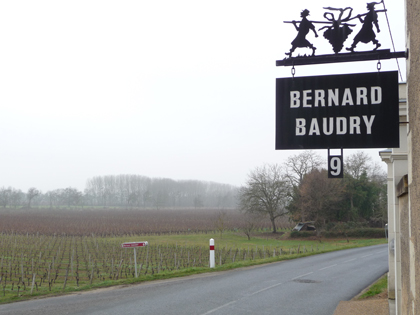
How does cabernet franc age? On my recent trip to the Loire, I got an excellent chance to explore this issue at the cellars of none other than Domaine Bernard Baudry in Chinon, one of my favorite producers in the Loire. Read more…



